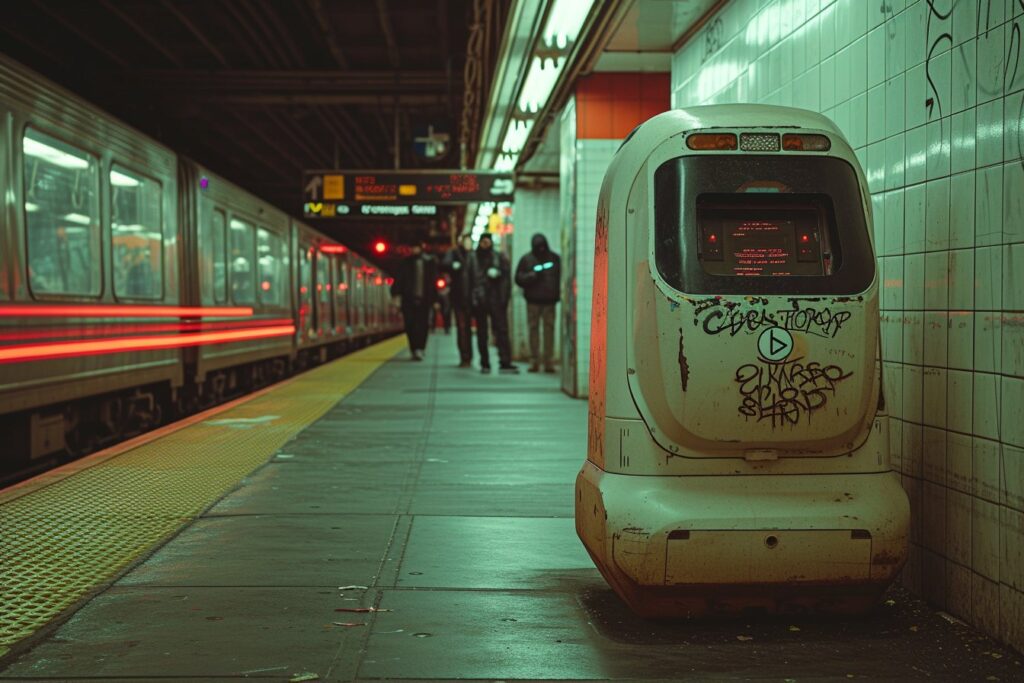In 2023, New York City introduced a new high-tech security measure to its subway system: the Knightscope K5 robot. Designed to assist police officers during night hours, this robotic sentinel quickly gained attention from both citizens and media alike. Despite initial optimism, however, the K5 soon proved to be more of a liability than an asset. Now, after just six months of service, it is being retired amidst a series of blunders and mishaps.
A Revolutionary Vision for Public Safety
When first introduced by Mayor Eric Adams, the Knightscope K5 appeared poised to revolutionize public safety in the city’s subways. Patrolling between midnight and 6 AM, this impressive machine promised round-the-clock surveillance – something human officers simply could not match. To further increase its appeal, operating costs were significantly lower than those incurred by employing additional law enforcement personnel, with a rental fee of only nine dollars per hour.
A Series of Troubling Incidents
Sadly, the reality of the K5’s deployment quickly veered off course, as a number of troubling incidents involving the robot made headlines:
- An unintentional swim: The K5 caused quite a stir when it plunged into a fountain at Washington Mall. Unable to extract itself, humans had to intervene to rescue the waterlogged sentry.
- The baby incident: In 2016, a K5 gruesomely ran over the feet of a 16-month-old child, raising serious concerns about its ability to distinguish between innocents and potential criminals.
- Battle scars: An intoxicated man managed to punch through the K5’s “face”, humiliating the bot and leading critics to question its durability and overall effectiveness.
These high-profile setbacks, combined with persistent technical issues hindering effective patrolling in the subway system, led to the decision to retire the K5 early from service.
A Wake-Up Call for AI-Security Optimists
The premature retirement of the Knightscope K5 serves as an important reminder: despite the dazzling promise of robotic technology, we are a long way from a world where robots can replace human judgment and intuition. Mayor Adams’ bold vision fell well short of its intended outcome, reminding us that the road to progress is often rife with unexpected pitfalls.
Reassessing Our Priorities
In light of K5’s failed experiment, cities must reassess their priorities when it comes to public safety and security measures. Rather than allocating resources toward unproven futuristic ventures, perhaps it would be wiser to invest in tried-and-true methods like expanded police presence and comprehensive training programs.
The Importance of Human Oversight
Even if advanced robotics eventually become an integral part of law enforcement operations, the importance of maintaining strong human oversight cannot be overstated. Time and time again, we have seen the stark limitations of algorithms and artificial intelligence – they certainly play a role in modern policing, but they must be kept firmly under control lest they create more harm than good.
Lessons Learned for the Future of Security Tech
As technology continues to evolve at a breakneck pace, it’s crucial to tread carefully during integration with essential services like law enforcement. The Knightscope K5 debacle has shown beyond a doubt that completely hands-free robotic security isn’t yet viable. Authorities should take this lesson to heart and find ways to strike a balance between the efficiency and cost-effectiveness of robotic technology with the discernment and decision-making abilities unique to humans.
Improving AI Through Collaboration
In order for AI-enhanced security measures to progress, developers must take a humble approach and actively collaborate with law enforcement experts. By combining their shared experience, they can better explore ways to augment human capabilities rather than pursuing unrealistic visions of fully automated policing.
In conclusion, the story of New York’s Knightscope K5 exemplifies a valuable learning opportunity for both tech enthusiasts and pragmatic urban planners alike: while robotics and artificial intelligence hold immense potential for enhancing public safety, blind optimism in their all-encompassing efficacy can be downright dangerous. The case of K5 should stand as a cautionary tale, urging us to consider the limitations and consequences of substituting machines for humans and highlighting the opportunities that arise from embracing a more collaborative mindset.


